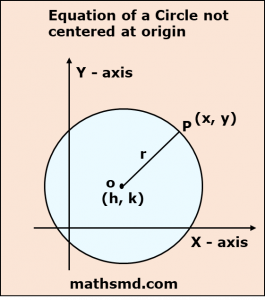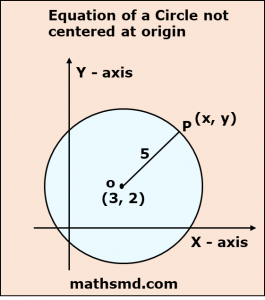Equation of a Circle (Not Centered at Origin)
Equation of a Circle when Center is not Origin
let’s dive into the equation of a circle when its center is not at the origin.
Standard Equation of a Circle
The general equation of a circle in a Cartesian coordinate system is:
(x−h)2+(y−k)2 = r2
Here, (h, k) represents the coordinates of the center of the circle, and r represents the radius of the circle.
Derivation of the Equation
To understand how this equation is derived, let’s go step-by-step.
(1) Distance Formula:
The distance d between two points in the Cartesian plane is given by
d = ✓{(x2−x1)2+(y2−y1)2}
Definition of a Circle:
A circle is the set of all points (x, y) that are a fixed distance (radius r) from a given point (the center of the circle, (h, k).
Applying the Distance Formula:
For a point (x, y) on the circle, the distance to the center (h, k) is equal to the radius r. Using the distance formula, this relationship can be written as:
r=✓{(x−h)2+(y−k)2}
Squaring Both Sides:
To eliminate the square root, we square both sides of the equation:
r2=(x−h)2+(y−k)2
This equation now represents the standard form of the equation of a circle with center (h, k) and radius r.
Example
Let’s consider an example where the center of the circle is at (3,−2) and the radius is 5 units. Plugging in the center (h, k)=(3,−2) and the radius
r=5 into the standard equation:
(x−3)2+(y+2)2=52
Simplifying the equation:
(x−3)2+(y+2)2=25
This is the equation of the circle with center (3,−2) and radius 5.
Graphical Representation
To visualize this, consider the following points:
The center of the circle (h, k)=(3,−2).
radius r=5, which means every point on the circle is 5 units away from the center.
If we plot the center at (3,−2) and draw a circle around it with a radius of 5, every point
(x, y) on the circle will satisfy the equation
(x−3)2+(y+2)2=25.
Transformations and Shifts
When the center of the circle is at the origin (0, 0), the equation simplifies to: x2+y2=r2
Shifting the circle’s center from the origin to (h, k) results in the transformation:
This shift accounts for the circle being moved horizontally by h units and vertically by k units.
Conclusion
The equation (x−h)2+(y−k)2= r2 encapsulates all the essential information about a circle’s size and position in a coordinate plane.
The parameters (h, k) define the center, while r defines the radius, allowing for precise geometric representation and analysis.
(x−h)2+(y−k)2=r2
Equation of the circle when center is not origin.
Let P (x, y) are the cartesian coordinate of points on the circle, and (h, k) are the cartesian coordinate of the center of the circle, which is not the origin.
Therefore, OP is the radius of the circle.

The radius of the circle is OP.
By using distance formula,
(x – h)² + (y – k) ² = OP ²
Let radius of the circle is r.
Therefore, the equation of the circle with center (h, k) and radius r is
(x – h)² + (y – k)² = r²
Equation of the circle with center (3, 2) and radius 5 is

(x – h)² + (y – k)² = r²
(x – 3)² + (y – 2)² = 5²
(x – 3)² + (y – 2)² = 25
Conclusion
The equation of a circle centered at (h, k) with radius r is (x−h)2+(y−k)2=r2.
This equation represents all the points (x, y) that are at a distance r from the center (h, k).